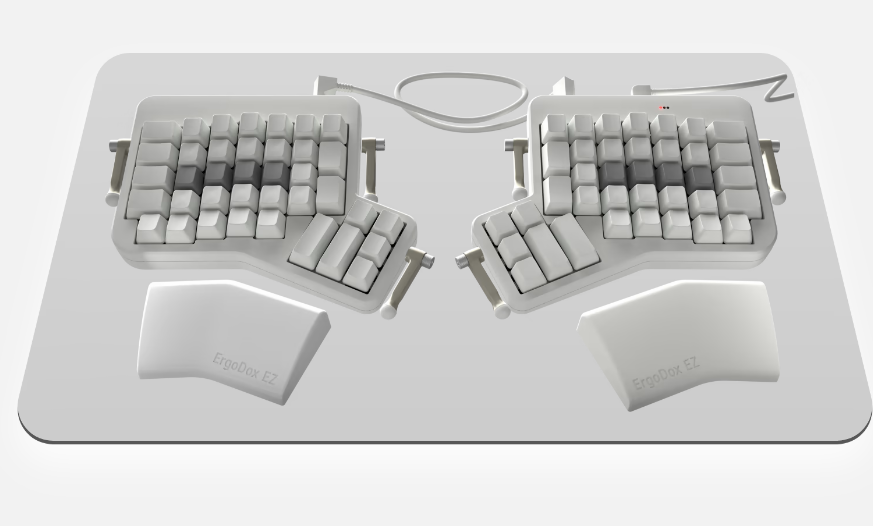Ergodox Keyboard Layout for Colemak, QWERTY and Dvorak
The case of ortholinear keyboard solutions
Series: Typing

A few months ago, I bought the Ergodox OrthoLinear Split Keyboard. After a period of trying it, I’ve found that the QWERTY layout was considerably uncomfortable to type in the keyboard disposition. I wasn’t the only one, of course, so I started the journey for searching a suitable layout. During a period of time, I switched back and forth between three layouts (QWERTY, Dvorak, and Colemak), although I picked Colemak at the end.
I really like Dvorak, but I’ve found that Colemak was better for me as I also use DAWs with a lot of shortcuts and other MacOs utilities. But also, because I found it natural. The balance of key frequency over the layout compensate both hands. Whether in Dorak, your left hand will work slightly more than your right.
First of all, does the Ergodox Keyboard pays-off?
Yes. Even tho, I saw some other interesting options such as UHK60, which is not Ortholinear, but it is a split keyboard. But, the Ortholinear Keyboard was something that I wanted to give a try. It was a bold move, cause at that time the price was easily over the 350USD (no cap keys, and cherry switches bloated the price).
The design is stern, the overall quality is good, although from outside it doesn’t seem a sophisticated keyboard. Probably at first look it does not look like a expensesive piece of hardware. It shines in other aspects, not only because is a programmable keyboard, but because it can be fully customized.
My veredict, it worth it. I’m using it daily, no regrets so far. I’m probably buying another with the same characteristics (Split-Ortholinear), for having a backup.
What has been using a completely new layout?
Even tho I don’t have decent stats on what was my previous typing speed before the switch, the overall perception is that speed wasn’t much of an improvement. I mean, I’m sure there is, but not quantified.
However, there is a perceptible comfort on typing, less finger stress at the end of the day. In the other hand, switching time to time to QWERTY isn’t without some time of catch-up, but not forgotten entirely. The problem of this resides on the fact that I started to practice 10-finger technique (I was doing touch typing tho) after switching setups (from an ISO/QWERTY keyboard to an Split-Ortholinear keyboard with a Colemak layout). That mean that I was able to type blindly, but I wasn’t using my fingers properly.
Aside of those drawbacks, the overall is that I’m still comfortable with Colemak layout. Regarding the split-ortholinear key disposition, my opinion is that it pays of.
The thing is, I would not use QWERTY on my split keyboard, as I found it quite hard to get use to it. It seems that if you pick an ortholinear keyboard, you might want to swith layouts. There are standard split keyboards in the market, if you don’t want to walk through the painful training that an ortholinear requires.
Beyond those physical enhancements, advanced keyboards today support programming, allowing you to develop custom shortcuts. That’s what I think what makes these keyboards shine: macros, special keys placement, layers, etc.
Why fingers turn crazy between keyboard dispositions?
Some observations that I couldn’t yet figure out:
- Between ISO and the Ergodox, the finger that hits space changes. In my ISO, the right thumb does that. In the Ergodox, the left finger does it. Why? I’m not sure. I tried to force myself to switch to the right thumb in the Ergodox, but I found myself pressing with the left thumb most of the time.
- Keys in the Ergodox have more space in between, so the edge keys remain a little bit more unreachable than in the ISO. Although isn’t a huge deal, it is perceptible.
- Probably one of my mistakes was to pick cherry switches for the Ergodox. They are silent and fast, but sensitive enough to be more inacurate. Although, your office coworkers might appreciate it.
The search of the most compatible layout
Colemak leverages QWERTY compatibility with a few changes that makes hot keys to be in the middle row, however, not all the programmable keyboards are the same, and the layouts may be slightly different in between. That is, at the end, you may end up using subvariations of a layout depending on your collection of noisy and clicky keyboards.
Let me tell you that it isn’t a huge problem, as you will keep some muscle memory when switching between keyboards, although it will be quite confusing at the beginning when designing your own layout.
So, at the end, I’ll recommend to customize as much as you can, until you start feeling annoyed by errors.
Is this a religion or it is just for nerds?
Definitively for nerds, and marketing.
Why not Dvorak?
I took a decent time investigating before jumping into Colemak. Keeping some compatibility with QWERTY pays off, really. Dvorak is more precise in my case, and it wasn’t that hard to switch at the beginning, but it felt weird. Don’t get me wrong, I’m pretty sure I wouldn’t have regreats if the choice was different, but the only thing that matter to me was to have a layout more suitable for ortholinear keyboards, not speed by itself.
Keep in mind that Dvorak is the only standard alternative to QWERTY, that’s something to consider – ofc, Colemak has been pushing a lot to get it available on most OS distributions.